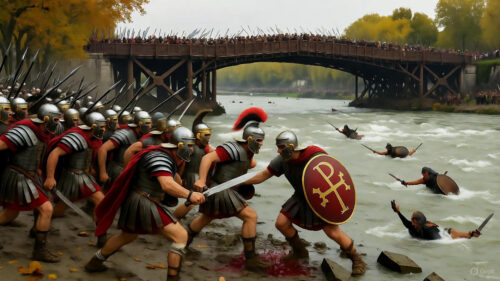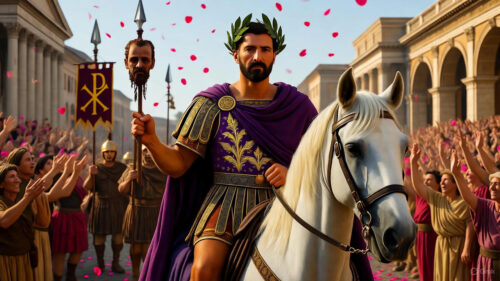Imagine a crisp autumn day in ancient Italy, where the fate of an empire hung by the thread of a river crossing. On October 27, 312 AD, two Roman emperors faced off in a battle that would not only decide who wore the purple but also reshape the religious landscape of the Western world. This wasn’t just another skirmish in the endless Roman civil wars; it was the Battle of the Milvian Bridge, a dramatic showdown between Constantine the Great and his rival Maxentius. Picture armored legions clashing under a dramatic sky, bridges collapsing into churning waters, and a visionary sign that some say came straight from the heavens. This event, buried in the annals of distant history, marked a turning point for Rome and, indirectly, for global history. Let’s dive deep into the intrigue, the strategy, and the chaos of that fateful day, exploring how one man’s bold decisions echoed through centuries.
The Roman Empire in the early 4th century was a powder keg of ambition, divided and unstable after decades of internal strife. To understand the Battle of the Milvian Bridge, we must first rewind to the reforms of Emperor Diocletian, who ruled from 284 to 305 AD. Diocletian, a no-nonsense military man from humble origins in Dalmatia, had risen through the ranks during the chaotic “Crisis of the Third Century,” a period when emperors were assassinated faster than you could say “Ave Caesar.” Facing invasions from barbarians, economic collapse, and usurpers popping up like weeds, Diocletian devised the Tetrarchy—a system of four co-emperors to share the burden of governing the vast empire. He appointed himself as Augustus of the East, with Maximian as Augustus of the West, and two junior Caesars: Galerius in the East and Constantius Chlorus in the West.
This setup was meant to prevent power vacuums and ensure smooth succession, but human nature had other plans. Diocletian and Maximian abdicated in 305 AD, elevating Constantius and Galerius to Augusti, with Severus and Maximinus Daia as the new Caesars. The system ignored hereditary claims, which proved disastrous. When Constantius Chlorus died in 306 AD while campaigning in Britain, his troops in Eboracum (modern York) immediately proclaimed his son, Constantine, as Augustus. Constantine, born around 272 AD in Naissus (modern Niš, Serbia), was a battle-hardened general with a keen political mind. He had served under Diocletian and Galerius, even surviving a perilous episode where Galerius allegedly sent him on suicide missions against the Sarmatians to eliminate him as a rival.
Meanwhile, in Rome, Maxentius—son of the retired Maximian and Constantine’s brother-in-law through marriage to Fausta—seized power on October 28, 306 AD, exactly six years before the battle. Maxentius styled himself as a defender of traditional Roman values, restoring temples and building grand structures like the Basilica of Maxentius. But he was seen as a usurper by the Eastern emperors. Galerius dispatched Severus to crush him in 307 AD, but Severus’s army defected, leading to his capture and death. Galerius himself invaded Italy later that year but couldn’t breach Rome’s defenses and retreated after his troops began plundering their own countryside.
Constantine played a shrewd game during these years. From his base in Trier (Augusta Treverorum), he consolidated control over Gaul, Britain, and Spain. He married Fausta in 307 AD to cement alliances, though the union was politically motivated and later marred by tragedy. By 310 AD, Constantine publicly distanced himself from the Tetrarchy’s pagan persecutions, hinting at his evolving religious views. He claimed divine favor from Apollo or Sol Invictus, the Unconquered Sun, in a panegyric delivered at Trier. Tensions with Maxentius escalated when Maxentius executed Constantine’s father-in-law Maximian in 310 AD after a failed coup. Popular unrest in Rome, fueled by food shortages and heavy taxes under Maxentius, created an opening. Constantine decided to strike in 312 AD, invading northern Italy with a force of about 40,000 men—half his total army, leaving the rest to guard the Rhine frontier against Germanic tribes.
The campaign was swift and brutal. Constantine first besieged Segusio (modern Susa), breaching its walls with a daring assault. At the Battle of Turin, his cavalry shattered Maxentius’s heavy cataphracts, armored horsemen inspired by Eastern styles. The victors then marched on Verona, where Maxentius’s praetorian prefect, Ruricius Pompeianus, holed up with a large force. Constantine besieged the city, repelling a relief army and killing Pompeianus in the ensuing battle. With northern Italy secured, Constantine advanced on Rome, his path cleared of major opposition.
Maxentius, ensconced in the eternal city, had options. He could have waited behind Rome’s formidable Aurelian Walls, as he had successfully done against Galerius. The city was well-stocked, and a siege would strain Constantine’s supply lines. But ancient sources suggest hubris and omens swayed him. The battle’s date fell on the anniversary of his accession, which he took as a good sign. He consulted the Sibylline Books, ancient prophetic texts guarded by priests, which foretold that “an enemy of the Romans would perish” on that day. Maxentius interpreted this as Constantine’s doom. Pagan historian Zosimus claims Maxentius was influenced by superstitious advisors, while Christian writers like Lactantius portray him as a tyrant despised by the populace.
Maxentius deployed his army—estimated at 25,000 to 50,000, including the elite Praetorian Guard and Moorish cavalry—north of the Tiber, in front of the Milvian Bridge. This stone arch bridge, originally built in 206 BC by consul Gaius Claudius Nero and rebuilt in 109 BC, spanned the river along the Via Flaminia. To prevent Constantine from crossing easily, Maxentius may have partially destroyed it and erected a temporary pontoon bridge nearby, possibly rigged to collapse as a trap. His positioning was flawed: the river at his back limited maneuverability, turning any retreat into a potential disaster.
Constantine, arriving from the north, encamped at Malborghetto, about 12 miles from Rome. A triumphal arch later built there commemorated his victory. His army, though smaller, was battle-tested and loyal, drawn from Germanic auxiliaries, Illyrian legions, and British troops. Units like the Cornuti, with their distinctive horned helmets, would play key roles.
Now, enter the most legendary aspect: Constantine’s vision. According to Christian chronicler Eusebius in his “Life of Constantine,” written around 337 AD based on the emperor’s own testimony, Constantine and his army witnessed a miraculous sign while marching southward. Above the midday sun, a cross of light appeared with the Greek words “En toutō nika”—”In this sign, conquer.” That night, Constantine dreamed of Christ instructing him to use the symbol as a safeguard. Eusebius describes the labarum, a military standard topped with the Chi-Rho (☧), the monogram of Christ formed by the first two Greek letters of his name. Soldiers painted the symbol on their shields.
Lactantius, in “On the Deaths of the Persecutors” (circa 315 AD), offers a slightly different account: Constantine received the command in a dream to mark shields with a “heavenly sign of God,” possibly a staurogram resembling a cross with a loop. These narratives, while varying in details, converged in popular memory. Was it a genuine religious experience, a psychological boost, or a clever propaganda tool? Modern scholars debate. Some suggest a natural phenomenon like a solar halo or sun dog, where ice crystals refract light into cross-like shapes. Constantine’s coins from 310 AD already featured Sol Invictus, and his victory arch in Rome includes pagan solar imagery, indicating his conversion was gradual, not instantaneous.
Skeptics like historian Edward Gibbon in “The Decline and Fall of the Roman Empire” (1776) viewed the vision as a later embellishment to legitimize Constantine’s rule among Christians. Yet, the symbol’s adoption marked a shift: Christianity, persecuted under Diocletian, began its ascent. Constantine wasn’t baptized until his deathbed in 337 AD, but his policies favored the faith, culminating in the Edict of Milan in 313 AD, co-issued with Eastern co-emperor Licinius, granting religious tolerance.
As dawn broke on October 27, the armies arrayed for battle. Constantine’s forces, perhaps 20,000-25,000 strong after campaign losses, faced Maxentius’s similarly sized army. The terrain favored neither: open fields north of the Tiber, with the river swollen from autumn rains. Constantine opened with a cavalry charge, his horsemen—bolstered by Germanic allies—smashing Maxentius’s flanks. The clash was fierce; shields locked, swords flashed, and arrows darkened the sky. Constantine’s infantry, disciplined and motivated, pushed forward in tight formations, their shields possibly bearing the new Christian emblem.
Maxentius’s lines buckled. His Praetorians, veterans of many campaigns, fought valiantly, but poor placement doomed them. As retreat began, troops funneled onto the pontoon bridge. Under the weight of panicking soldiers and horses, it collapsed—whether by design or accident is unclear. Zosimus describes the structure giving way, plunging hundreds into the Tiber. Chaos ensued: men in heavy armor drowned, horses thrashed in the current, and Constantine’s pursuers cut down the stranded.
Maxentius himself met a grim end. Attempting to flee, his horse threw him into the river, or he was pushed in the crush. Lactantius relishes the detail: “The multitude pressing on him, he was driven headlong into the Tiber.” His body, weighed down by armor, sank; it was fished out the next day, decapitated, and paraded through Rome on a spear. The Praetorians made a desperate last stand, covering the ground with their bodies, as one source poetically notes.
Casualties were lopsided: Constantine lost few, while Maxentius’s army was decimated, with thousands killed or captured. The battle lasted mere hours, but its decisiveness stunned contemporaries. Constantine entered Rome on October 29 amid cheering crowds, who had reportedly chanted his name during Maxentius’s games. He addressed the Senate, promising clemency and restoring privileges stripped by Maxentius. No mass purges followed; instead, Constantine disbanded the Praetorian Guard, a 300-year-old institution, replacing it with his own scholae palatinae. Maxentius suffered damnatio memoriae—his statues toppled, laws annulled, and buildings renamed.
The aftermath rippled far beyond Rome. With the West secured, Constantine turned east, allying briefly with Licinius against Maximinus Daia. Their joint Edict of Milan ended Christian persecutions, allowing the faith to flourish. By 324 AD, Constantine defeated Licinius at Chrysopolis, becoming sole emperor. He founded Constantinople in 330 AD, shifting the empire’s center eastward. Christianity’s official status came with the Council of Nicaea in 325 AD, where Constantine presided over debates on doctrine, solidifying the Nicene Creed.
Historians draw from varied sources: Eusebius and Lactantius provide Christian-slanted views, emphasizing divine intervention. Pagan Zosimus blames Maxentius’s folly. Panegyrics from 313 and 321 AD laud Constantine as liberator. The Arch of Constantine, dedicated in 315 AD, tells the story through reliefs—some recycled from earlier emperors like Trajan and Marcus Aurelius, symbolizing continuity. Its inscription attributes victory to “the inspiration of the divinity,” ambiguous enough for pagan or Christian interpretation.
Art and literature immortalized the battle. Raphael’s frescoes in the Vatican (1520-1524) depict the vision and clash dramatically. Piero della Francesca’s 15th-century cycle in Arezzo includes a similar theme. In modern times, the battle inspires novels like Gore Vidal’s “Julian” (1964) and films like “Constantine” (2005), though loosely. Archaeologically, the Milvian Bridge still stands, rebuilt multiple times, a silent witness to history.
The Battle of the Milvian Bridge wasn’t just military triumph; it catalyzed Rome’s Christian transformation. Before 312, Christians were a minority, often persecuted. After, churches rose, bishops gained influence, and pagan temples waned. Constantine’s mother, Helena, sought holy sites in Jerusalem, discovering the True Cross. The empire’s Christianization influenced medieval Europe, the Byzantine legacy, and even the Renaissance.
Yet, Constantine’s legacy is complex. He executed his son Crispus and wife Fausta in 326 AD under murky circumstances. His reforms centralized power, paving the way for absolutism. Historians like Jacob Burckhardt (1853) saw him as a calculating politician using Christianity for unity, while others like Norman Baynes (1930) viewed him as sincerely converted.
Shifting gears to the present, what can we glean from this ancient drama? The outcome—Constantine’s victory and the rise of Christianity—teaches timeless lessons on vision, resilience, and transformation. Applying this historical fact to your individual life can spark personal growth, turning setbacks into comebacks.
– Embrace pivotal signs in your life: Just as Constantine interpreted his vision as a call to action, scan your daily experiences for “signs”—a chance encounter, a gut feeling, or an unexpected opportunity. For instance, if you’re stuck in a dead-end job, treat a networking email as your “cross in the sky” and pursue it aggressively.
– Build strategic alliances: Constantine’s marriage to Fausta and careful navigation of Tetrarchic politics show the power of relationships. In your career, identify mentors or partners who align with your goals; schedule monthly coffee chats to foster these bonds, mirroring Constantine’s consolidation of power.
– Prepare for decisive moments: The battle’s swift outcome stemmed from Constantine’s prior victories in Turin and Verona. Apply this by training for your “battles”—if aiming for a promotion, dedicate 10 hours weekly to skill-building courses, ensuring you’re battle-ready when opportunity strikes.
– Overcome internal rivals: Maxentius represents self-doubt or bad habits that block progress. Conduct a personal “audit”: list three self-sabotaging behaviors (e.g., procrastination), then devise countermeasures like time-blocking apps, much like Constantine dismantled the Praetorians.
– Celebrate victories to build momentum: After triumph, Constantine paraded into Rome and built monuments. Mark your wins—complete a project? Treat yourself to a special outing and journal the lessons, creating a “victory arch” in your mind for future motivation.
A practical plan to integrate these: Week 1: Reflect on past “visions” by journaling three turning points in your life and what they taught. Week 2: Strengthen one key relationship with a meaningful gesture. Week 3: Identify a personal “battle” (e.g., fitness goal) and prepare with daily habits. Week 4: Execute a small challenge, then celebrate. Repeat monthly, tracking progress in a dedicated notebook. This structured approach turns historical insight into actionable empowerment, proving that even ancient battles can fuel modern triumphs.
The battle’s echoes remind us that history isn’t just dates and dust—it’s a blueprint for boldness. Whether you’re navigating career shifts or personal hurdles, channel Constantine’s audacity: spot the sign, seize the moment, and conquer.

